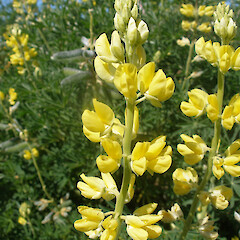Lupinus arboreus
Common name
tree lupin
Family
Fabaceae
Flora category
Vascular – Exotic
Structural class
Trees & Shrubs - Dicotyledons
NVS code
The National Vegetation Survey (NVS) Databank is a physical archive and electronic databank containing records of over 94,000 vegetation survey plots - including data from over 19,000 permanent plots. NVS maintains a standard set of species code abbreviations that correspond to standard scientific plant names from the Ngä Tipu o Aotearoa - New Zealand Plants database.
LUPARB
Conservation status
Not applicable
Habitat
Terrestrial. Short tussockland, bare land, riverbeds, coastal sandy and well drained areas.
Wetland plant indicator status rating
Information derived from the revised national wetland plant list prepared to assist councils in delineating and monitoring wetlands (Clarkson et al., 2021 Manaaki Whenua – Landcare Research Contract Report LC3975 for Hawke’s Bay Regional Council). The national plant list categorises plants by the extent to which they are found in wetlands and not ‘drylands’. The indicator status ratings are OBL (obligate wetland), FACW (facultative wetland), FAC (facultative), FACU (facultative upland), and UPL (obligate upland). If you have suggestions for the Wetland Indicator Status Rating, please contact: [Enable JavaScript to view protected content]
UPL: Obligate Upland
Rarely is a hydrophyte, almost always in uplands (non-wetlands).
Detailed description
Short-lived, perennial shrub to 2-3 m high. Deep taproot. Stems densely silky-hairy when young, tough, erect, branching, becoming soft-woody. Leaves grey-green, hairless above, silky below, divided into 5-11 leaflets spreading out from one point finger-like; leaflets 15-40 x 3-10 mm. Flowers pea-like, 15-18 mm long, usually pale yellow (rarely white or bluish), sweetly scented, Oct-May. Seed pod stout, softly hairy, 40-80 mm long, firmly attached; splits explosively to disperse dark brown, mottled seeds, 4-6 mm long.
Similar taxa
L. angustifolius blue lupin is a semi-woody annual with blue flowers Aug-Apr, occasionally weedy. L. polyphyllus herbaceos weedy species with blue flowers. Hybrid L. arboreus x polyphyllus has larger and more leaflets, flower yellow with blue or purple streaks; is rarely weedy.
Flowering
October, November, December, January, February, March, April, May
Flower colours
Yellow
Year naturalised
1899
Origin
California, N. America
Etymology
arboreus: From the Latin arbor ‘tree’, meaning tree-like
Reason For Introduction
Ornamental
Life Cycle Comments
Perennial.
Reproduction
Reproduces via seed.
Seed
Seed long-lasting in soil.
Dispersal
Water and soil movement. Explosive pods. Deliberately sown for sand consolidation, erosion control.
Tolerances
Tolerates wind, salt, hot to cold, physical damage and grazing (not readily eaten), drought, low fertility (fixes nitrogen), fire. Intolerant of moderate shade and waterlogged soils.
Poisonous plant:
The seed are poisonous if they are chewed or crushed before eating.


















